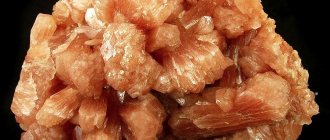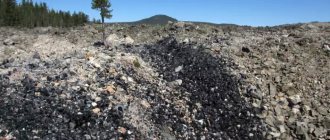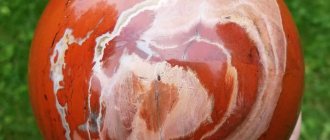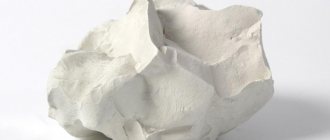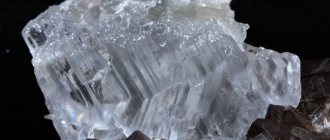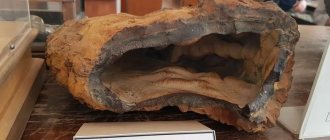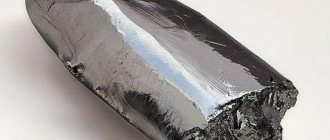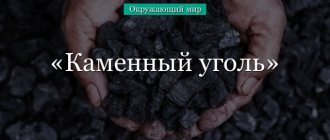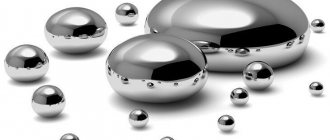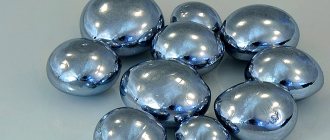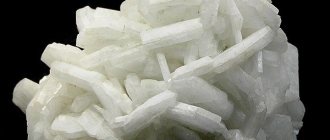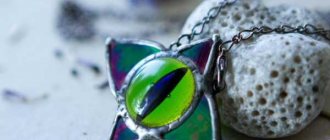Crystallographic characteristics
Monoclinic system; rhomboprismatic c. With. L2PC.
Etc. gr. P21/n (C52h). a0 = 9.27; b0 = 13.50; c0 = 6.56; β = 106° 33.′Axial ratio. 0.687: 1: 0.486; §=106°33/.
Crystal structure
Realgar has a rather complex crystal structure. It is built from individual As4S4 molecules. Sulfur ions form a square, and arsenic ions form a tetrahedron. The centers of the square and tetrahedron coincide.
Symmetry class. Prismatic - 2/gp.
Main forms: Crystals of the mineral are mostly short-prismatic. The most common combinations of shapes are: pinacoids {001}, {010} and rhombic prisms {110}, {120}, {011} and others.
.
Physical properties Optical
Mineral color
- Orange-red
- Bright red, less often dark red.
- Trait. Orange-yellow.
- Diamond shine on the edges of the crystals,
- The cast in the fracture is resinous or greasy.
- Transparency. Translucent.
Refractive indices
Ng = 2.61, Nm = 2.59 and Np = 2.46
Mechanical
- Hardness 1.5–2
- Density 3.4-3.6.
- The cleavage is quite perfect along {010} and {120}.
- Kink. Conchoidal.
- Density 3.4–3.6.
Chemical properties of the mineral Behavior in acids.
Dissolves in aqua regia, releasing sulfur. Dissolves in caustic alkalis. Unlike cinnabar, realgar dissolves in heated KOH, and the addition of HCl to the solution causes the appearance of a lemon-yellow flaky precipitate.
Other properties of realgar
Over time, under the influence of light, it turns into a light orange powder and decomposes to form As2O3 and As2s3. Under the influence of electric light, its crystals crack and turn into the same powder, and X-ray studies have established that this phenomenon is accompanied by the disintegration of the crystal structure. When heated in a closed tube, it gives a transparent red sublimation; in an open tube with slow heating - the smell of sulfur dioxide and white sublimation of As2O5.
The mineral does not conduct electricity.
Realgar mineral. Description, properties and applications of realgar
Rahj al har. This is the name of the mineral realgar . The phrase is translated as “mountain dust”. The typical form of stone is powdery, earthy clumps.
They scattered into the air as miners broke down cave rocks in search of ores and gems. This addition to the atmosphere ruined the miners. Their hemoglobin levels decreased, bronchitis and laryngitis began, weakness in the legs appeared, and the cerebral cortex was affected. Why? The answer should be found in the chapter “Properties of Realgar”.
Properties of realgar
The chemical composition of realgar is arsenic sulfide. In its pure form, element 33 is inert. However, arsenic compounds are poisonous in most cases. The most dangerous are oxides and arsenous hydrogen. Realgar is a mineral that, when reduced to dust, kills slowly. Inhaling portion after portion, the body is destroyed.
Arsenic has no smell or taste. Therefore, the element was a favorite poison during the Middle Ages. The 33rd substance was called the king of poisons and, often, kings and high-ranking persons were also poisoned with it. For example, Clement the 4th was killed with arsenic. In the 13th century he was Pope.
The properties of realgar are closely related to the history of poisons, since pure arsenic was isolated after the life of Clement the 4th. The single element turned out to be almost non-toxic.
Therefore, poisoners returned to using arsenic compounds, including realgar. It is not difficult to crush it. The hardness of the mineral does not exceed 2 points. We're talking about the Mohs scale.
Graphite occupies a two-point position in it. On the single point there is talc. Most arsenic sulfide samples have one and a half hardness. That is, making realgar powder is no more difficult than making baby powder.
Despite its low hardness, the mineral is heavy. The density of the stone is 3.6 grams per cubic centimeter. The outside is matte realgar. But if you split the mineral, a greasy sheen will appear.
If you type the query “ Realgar: photo ” you will get not only pictures with earthy masses, but also pictures with crystals. Arsenic sulfide actually does have them. The shape of the units is prismatic and the dimensions are small. Coming across realgar crystals is good luck for a mineralogist, since they are rarely formed.
Application of realgar
The era of poisoning has had its day. Modern methods, including an autopsy, make it possible to identify what exactly a person died from. In the old days, everything was attributed to heart disease and infectious diseases.
Now, realgar is used only for baiting agricultural pests. The mineral is also purchased in the leather industry. Realgar-based compositions help remove hair from animal skins.
Realgar is also used in glass production. Enamels are whitened with mineral powder. Whitish glass also rarely does without the addition of realgar. Its particles are securely captured by the quartz mass, do not enter the air, and are therefore safe. Arsenic sulfide is also added to a number of paints. The mineral was used as a dye in ancient Egypt.
Arsenic in realgar is more than 70%. Therefore, the mineral became not only a poison, but also a medicine. Paracelsus began to promote it. In modern medicine, the drug is used in the treatment of leukemia, that is, a malignant transformation of the blood.
With it, there is a pathologically active production of leukocytes. This is what the 33rd element is blocking. After all, as the same Paracelsus said: “Everything is poison and everything is medicine, it’s just a matter of dose.”
Realgar color
Mineral powder could not be a dye if it did not have a rich color. In realgar it is yellow-orange to red. The powder does not change color. That is, if you run a piece of realgar across a white ceramic plate, a reddish line will remain on it. Pliny called it sandarak. An ancient Roman writer mentions sandarac as one of the paints for frescoes.
It is worth noting that in nature there are three mineral varieties of arsenic. One of them is characterized by the formula As2O3 and white color. With the composition As2S3, the mineral is yellow. The reddish tone of realgar is due to the formula As4S4.
Realgar deposits
You can find realgar in ore veins. Here, the mineral’s companions are quartz, chalcedony, calcite, galena, and pyrite. The stone is also found among gypsum, like volcanic sublimate. This is the name for the separation of volatile components from magma and their precipitation separately from it.
It is easy to find realgar among classical sedimentary rocks, such as clays, limestones, dolomites, and coals. In Russia, they go to Transcaucasia to search for arsenic sulfide. There, the Elbrus mine is famous for its abundance of realgar. Outside the country, the mineral is mined in Greece, Czechoslovakia, Romania, Japan, Georgia and the USA.
Diagnostic signs of realgar
Similar minerals . Proustite, pyrargyrite, cinnabar, crocoite (red silver ore), orpiment.
Realgar is characterized by an orange-red color, low hardness, and streaked edges along the elongation axis of the crystals. Paragenesis with orpiment, easily identified by external signs, is also characteristic. It differs from similar crocoite (Pb[CrO4]) in lower hardness, the appearance of the crystals and the behavior of the material. with a blowpipe (on charcoal with soda, crocoite gives lead beetle). Cinnabar differs from realgar in its bright red streak, high specific gravity and underwater behavior. soldering tube.
Satellites. Native arsenic, stibnite, sphalerite, pyrite, orpiment. It is found as a companion in almost all orpiment deposits.
Links
Marcasite supergroup Marcasite group: Marcasite • Frobergite
- (including persulfides, antimonides, arsenides, bismuthides, selenides and tellurides)
grouped Acanthite group: Acanthite |
Arsenopyrite group:
Arsenopyrite |
Orpiment group:
Orpiment • Getcellite |
Bornite group:
Bornite |
Wurtzite Group:
Wurtzite |
Galena group:
Altaite • Galena |
Germanite group:
Renierite |
Cobaltine group:
Cobaltine • Ulmanite |
Krennerite group:
Calaverite • Krennerite • Sylvanite |
Kubanit group:
Kubanit |
Linneite group:
Violarite • Carrolite • Linneite • Polydymite |
Melonite group:
Melonite |
Molybdenite group:
Molybdenite |
Nikelin group:
Nikelin |
Pentlandite group:
Pentlandite |
Realgar's group: Realgar | Stannin group:
Stannin |
Stibnite (antimonite) group:
Bismuthin • Stibnite (antimonite) |
Coloradoite group:
Coloradoite • Sphalerite,
a variety of Marmatite
|
Tetradymite group:
Tetradymite |
Chalcozine group:
Chalcozine |
Chalcopyrite group:
Chalcopyrite |
Uytenbogardtite group:
Petziteother Volcanite • Hessite • Cinnabar • Covelline • Kurilite • Millerite • Pyrrhotite • Ricardite • Skutterudite, Smaltin variety • Troilite • Ferrotochilinite • Yushkinite
List of minerals • Portal "Mineralogy" •
Project "Geology"
Origin and location
Realgar and orpiment are rare minerals. Realgar is of hydrothermal and volcanic origin.
It is a typical representative of epithermal deposits. It is found in hydrothermal deposits, formed in sublimates of volcanoes, fumaroles and solfataras, and also as a chemical precipitate in dolomites, clays and marls. In nature, it is found in similar conditions with orpiment, with which it is paragenetically constantly associated. It is never found on the surface itself, since under the influence of light it is destroyed and partially transformed into orpiment.
Deposits and deposits
Hytology and associated minerals
Hytology A common mineral of hydrothermal veins at low temperatures, associated with the minerals arsenic and antimony. associated minerals are orpiment, arsenolite, calcite, barite.
Wonderful deposits
In France
- My Matra, Corsica (which accounted for almost 10% of world production between 1912 and 1939)
- Gabe Gottes mine, Sainte-Marie-aux-Mines, Haut-Rhin[5]
- La Ricamari, Saint-Etienne, Loire[6]
- Le Gois near Aubin, Decazeville Coalfield, Aveyron[7]
There are also deposits in the United States (Nevada), in Russia (Caucasus) or in Switzerland or Romania...
Realgar deposits
In Russia, manifestations of realgar have been noted in the river basin. Schrenk in Taimyr, in the Elbrus mine (North Caucasus) and in the Sarasin deposit (Altai).
Exceptionally large (up to 1–2 cm) crystals and beautiful druses of realgar were found in the Lukhumi deposit (Rachinsky ridge on the southern slope of the Caucasus, Western Georgia) in association with orpiment, occasionally stibnite, pyrite, marcasite, melnikovite, quartz, calcite and others.
Realgar locations are located in the volcanic activity zones of Jáchymov in the Ore Mountains (Czech Republic); volcanoes of the inner arc of the Carpathians (Romania); in solfataras near Pozzuoli, in the vicinity of Naples, lavas and fumaroles of Vesuvius (Italy)
Realgar crystal structure, genesis, photo
The name comes from the Arabic word meaning “mine dust.”
Realgar formula
As 4 S 4 (formerly AsS formula)
Realgar. Georgia
Chemical composition of the mineral
The realgar mineral consists of arsenic (As) - 70.1%; sulfur (S) - 29.9%. The data from chemical analyzes almost correspond to the theoretical ones. Isomorphic impurities of other elements are not established.
Crystallographic characteristics
Monoclinic system; rhomboprismatic c. With. L2PC.
Etc. gr. P21/n (C 5 2h). a0 = 9.27; b0 = 13.50; c0 = 6.56; β = 106° 33.′Axial ratio. 0.687: 1: 0.486; §=106°33/.
Realgar has a rather complex crystal structure. It is built from individual As4S4 molecules. Sulfur ions form a square, and arsenic ions form a tetrahedron. The centers of the square and tetrahedron coincide.
Symmetry class. Prismatic - 2/gp.
Main forms: Crystals of the mineral are mostly short-prismatic. The most common combinations of shapes are: pinacoids, and rhombic prisms, and others.
Form of being in nature
Realgar crystals typically have a prismatic appearance; they are shortened or elongated along the vertical axis, parallel to which thin shading is observed on the edges.
Realgar aggregates are also observed in the form of solid granular aggregates, sometimes plaques, crusts or earthy loose masses.
Physical properties Optical
- Orange-red
- Bright red, less often dark red.
- Trait. Orange-yellow.
- Diamond shine on the edges of the crystals,
- The cast in the fracture is resinous or greasy.
- Transparency. Translucent.
Ng = 2.61, Nm = 2.59 and Np = 2.46
Mechanical
- Hardness 1.5–2
- Density 3.4-3.6.
- The cleavage is quite perfect in terms of and.
- Kink. Conchoidal.
- Density 3.4–3.6.
Chemical properties of the mineral Behavior in acids.
Dissolves in aqua regia, releasing sulfur. Dissolves in caustic alkalis. Unlike cinnabar, realgar dissolves in heated KOH, and the addition of HCl to the solution causes the appearance of a lemon-yellow flaky precipitate.
Other properties of realgar
Over time, under the influence of light, it turns into a light orange powder and decomposes to form As2O3 and As2s3. Under the influence of electric light, its crystals crack and turn into the same powder, and X-ray studies have established that this phenomenon is accompanied by the disintegration of the crystal structure. When heated in a closed tube, it gives a transparent red sublimation; in an open tube with slow heating - the smell of sulfur dioxide and white sublimation of As2O5.
The mineral does not conduct electricity.
Diagnostic signs of realgar
Similar minerals . Proustite, pyrargyrite, cinnabar, crocoite (red silver ore), orpiment.
Realgar is characterized by an orange-red color, low hardness, and streaked edges along the elongation axis of the crystals. Paragenesis with orpiment, easily identified by external signs, is also characteristic. It differs from similar crocoite (Pb[CrO4]) in lower hardness, the appearance of the crystals and the behavior of the material. with a blowpipe (on charcoal with soda, crocoite gives lead beetle). Cinnabar differs from realgar in its bright red streak, high specific gravity and underwater behavior. soldering tube.
Satellites. Native arsenic, stibnite, sphalerite, pyrite, orpiment. It is found as a companion in almost all orpiment deposits.
Origin and location
Realgar and orpiment are rare minerals. Realgar is of hydrothermal and volcanic origin.
It is a typical representative of epithermal deposits. It is found in hydrothermal deposits, formed in sublimates of volcanoes, fumaroles and solfataras, and also as a chemical precipitate in dolomites, clays and marls. In nature, it is found in similar conditions with orpiment, with which it is paragenetically constantly associated. It is never found on the surface itself, since under the influence of light it is destroyed and partially transformed into orpiment.
Realgar deposits
In Russia, manifestations of realgar have been noted in the river basin. Schrenk in Taimyr, in the Elbrus mine (North Caucasus) and in the Sarasin deposit (Altai).
Exceptionally large (up to 1–2 cm) crystals and beautiful druses of realgar were found in the Lukhumi deposit (Rachinsky ridge on the southern slope of the Caucasus, Western Georgia) in association with orpiment, occasionally stibnite, pyrite, marcasite, melnikovite, quartz, calcite and others.
Realgar locations are located in the volcanic activity zones of Jáchymov in the Ore Mountains (Czech Republic); volcanoes of the inner arc of the Carpathians (Romania); in solfataras near Pozzuoli, in the vicinity of Naples, lavas and fumaroles of Vesuvius (Italy)
Practical application of realgar
Practical Importance – Arsenic Ore
It is one of the rare minerals. Very rarely, together with orpiment, it forms purely arsenic deposits (Lukhumskoye). In these cases, it is of practical interest as a raw material for the production of As 2 O 3 (by roasting). Arsenic sulphide (AsS), both natural and artificial, has applications in dyeing, pyrotechnics, glass making and other industries.
Physical research methods
Ancient methods. Under the blowpipe. It melts and evaporates easily (emitting a garlicky smell of arsenic), a red sublime appears in the flask and burns with a blue flame.
